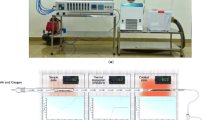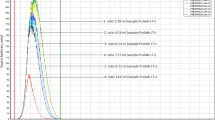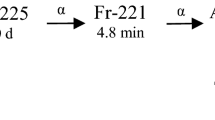Abstract
The ideal method for monitoring the environment should be rapid, low cost, and sufficiently sensitive to detect any changes caused by nuclear facilities during their normal operation. A combined initial preparation step for environmental samples in the detection of organically bound tritium (OBT) and radiocarbon (14C) makes the analytical process quicker, while the use of a Parr 1121 large-capacity oxygen vessel, which allows the combustion of around 20 g of dried organic sample, reduces the detection limits for both parameters. The method was validated with inter-laboratory intercomparisons for the OBT and a comparison with the official values of environmental samples for the 14C.




Similar content being viewed by others
References
Kim DJ, Warwick P, Croudace IW (2008) Tritium speciation in nuclear reactor bioshield concrete and its impact on accurate analysis. Anal Chem 80:5476–5480
de Visser-Týnová E, Swanton SW, Williams SJ, Stijkel MP, Walker AJ, Otlet RL (2018) 14C release from irradiated stainless steel. Radiocarbon 60(6):1671–1681
Blowers P, Davis T (2006) Comparison of analysis techniques for determination of carbon-14 in solid materials. CEFAS Poster
Oh JS, Warwick PE, Croudace IW, Lee SH (2014) Rapid determination of tritium and carbon-14 in urine samples using a combustion technique. J Radioanal Nucl Chem 299:187–191
Leskinen A, Hokkinen J, Kärkelä T, Kekki T (2022) Release of 3H and 14C during sampling and speciation in activated concrete. J Radioanal Nucl Chem 331:859–865
Hou XL (2005) Rapid analysis of 14C and tritium in graphite and concrete for decommissioning of nuclear reactor. Appl Radiat Isot 62:871–882
International Atomic Energy Agency (2010) Handbook of parameter values for the prediction of radionuclide transfer in terrestrial and freshwater environments. Technical Reports Series no. 472
Nayak SR, D’Souza RS, Kamath SS, Mohan MP, Bharath S, Shetty T, Kumara KS, Narayana B, Dileep BN, Ravi PM, Karunakara N (2019) Organically bound tritium: optimization of measurements in environmental matrices by combustion method and liquid scintillation spectrometry. J Radioanal Nucl Chem 315:917–926
Nayak SR, D’Souza RS, Purushotham MM, Seraje B, Blangat DN, Mana RP, Naregundi K (2021) Determination of organically bound tritium (OBT) concentration in fish by thermal oxidation and liquid scintillation counting method. Health Phys 120(1):1–8
Marsh RI, Croudace IW, Warwick PE, Cooper N, St-Amant N (2017) A new bomb-combustion system for tritium extraction. J Radioanal Nucl Chem 314(2):651–658
Sheppard H, Rodegker W (1962) Determination of H3 and Cl4 in biological materials using oxygen bomb combustion. Anal Biochem 4:246–251
Varlam C, Vagner I, Faurescu I, Faurescu D (2015) Combustion water purification technique influence on OBT analysis. Fusion Sci Technol 67:623–626
Vagner I, Varlam C, Faurescu I, Faurescu D, Bucura F (2017) Comparison of two methods for 14C analysis from essential oils using LSC. J Radioanal Nucl Chem 314:709–713
International Organization for Standardization (2010) ISO 9698 Water quality—Determination of tritium activity concentration—Liquid scintillation counting method. 2:1–24
International Organization for Standardization (2010) ISO 11929 Determination of the characteristic limits (decision threshold, detection limit and limits of the coverage interval) for measurements of ionizing radiation
International Organization for Standardization (2015) ISO 13528 Statistical methods for use in proficiency testing by interlaboratory comparison
I Z V J E Š Ć E o mjerenjima aktivnosti 14C u okolišu Nuklearne elektrane Krško tijekom (2021) godine LNA-7/2022, Ruđer Bošković Institute, Zagreb (in Croatian)
I Z V J E Š Ć E o mjerenjima aktivnosti 14C u okolišu Nuklearne elektrane Krško tijekom (2018) Godine LNA-5/2019, Ruđer Bošković Institute, Zagreb (in Croatian)
I Z V J E Š Ć E o mjerenjima aktivnosti 14C u okolišu Nuklearne elektrane Krško tijekom (2019) Godine LNA-5/2020, Ruđer Bošković Institute, Zagreb (in Croatian)
I Z V J E Š Ć E o mjerenjima aktivnosti 14C u okolišu Nuklearne elektrane Krško tijekom (2020) Godine LNA-5/2021, Ruđer Bošković Institute, Zagreb (in Croatian)
Chipanovska N, Krištof R, Gerjol P, Kožar Logar J (2022) Method validation for determination of 14C with the use of CO2 absorption method. J Environ Radioact. https://doi.org/10.1016/j.jenvrad.2022.106985
Kim SB, Olfert J, Baglan N, St-Amant N, Carter B, Clark I, Bucur C (2015) Canadian inter-laboratory organically bound tritium (OBT) analysis exercise. J Enivron Radioact 150:236–241
Acknowledgements
Sampling of the organic environmental samples around KNPP was performed together with personnel from Laboratory for Low Level Radioactivities at the Ruđer Bošković Institute, Zagreb, Croatia. We want to thank Polona Gerjol for her involvement in the practical part of this research, as well as for her constructive suggestions.
Author information
Authors and Affiliations
Contributions
All authors have participated in (a) Conception and design, or analysis and interpretation of the data; (b) Drafting the article or revising it critically for important intellectual content; and (c) Approval of the final version.
Corresponding author
Ethics declarations
Conflict of interest
The authors declared that they have no conflict of interest.
Additional information
Publisher's Note
Springer Nature remains neutral with regard to jurisdictional claims in published maps and institutional affiliations.
Rights and permissions
Springer Nature or its licensor holds exclusive rights to this article under a publishing agreement with the author(s) or other rightsholder(s); author self-archiving of the accepted manuscript version of this article is solely governed by the terms of such publishing agreement and applicable law.
About this article
Cite this article
Krištof, R., Chipanovska, N. & Kožar Logar, J. Determining the amounts of organically bound tritium and radiocarbon using a combined preparation step and liquid scintillation spectrometry. J Radioanal Nucl Chem 332, 1521–1526 (2023). https://doi.org/10.1007/s10967-022-08586-6
Received:
Accepted:
Published:
Issue Date:
DOI: https://doi.org/10.1007/s10967-022-08586-6




